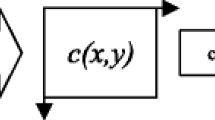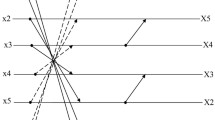Abstract
In [Dhandapani and Ramachandran, “Area and power efficient DCT architecture for image compression”, EURASIP Journal on Advances in Signal Processing 2014, 2014:180] the authors claim to have introduced an approximation for the discrete cosine transform capable of outperforming several well-known approximations in literature in terms of additive complexity. We could not verify the above results and we offer corrections for their work.
Similar content being viewed by others
1 Introduction
In a recent paper [1], a low-complexity transformation was introduced, which is claimed to be a good approximation to the discrete cosine transform (DCT). We wish to evaluate this claim.
The introduced transformation is given by the following matrix:
We aim at analyzing the above matrix and showing that it does not consist of a meaningful approximation for the 8-point DCT. In the following, we adopted the same methodology described in [2–11] which the authors also claim to employ.
2 Criticisms
2.1 Inverse transformation
The authors of [1] claim that inverse transformation T −1 is given by
However, simple computation reveal that this is not accurate, being the actual inverse given by:
2.2 Lack of DC component
The first point to be noticed is that the matrix T lacks a row of constant entries. Therefore, it is not capable of computing the mean value or the DC component of a signal under analysis. In terms of image compression, the DC value is the single most important coefficient concentrating most of the image energy. To illustrate this fact, Fig. 1 shows the reconstructed standard Lena image by means of (i) the DC component of the standard DCT, (ii) all DCT coefficients, except the DC component, (iii) the first row of matrix T [1], and (iv) all T coefficients, except the first row, respectively. In [12], Britanak meticulously cataloged dozens of DCT approximations; all of them computed the DC component. The lack of the DC component computation suggests that compressed images resulting from the application of T are expected to be severely degraded in terms of perceived image quality. The associated PSNR values in Fig. 1 also show the poor quality of the reconstructed images using T. Considering M×N pixel images, the PSNR measure is calculated by:
Reconstructed Lena image based a only on the DC component of the DCT, b on all DCT transform coefficient except the DC component, c only on the first row of the T [1], and d on all T coefficients, except the first row
where \(\text {MSE} = \frac {1}{M\cdot N} {\sum \nolimits }_{i=1}^{M}{\sum \nolimits }_{j=1}^{N} (a_{i,j} - b_{i,j})^{2}\), a i,j and b i,j are the (i,j)-th element of the original and reconstructed images, respectively; and MAX is the maximum pixel valye. For 8-bit greyscale images, MAX = 255.
2.3 Fast algorithm
In the ‘Fig. 1’ of [1], the authors display a signal flow graph (SFG) which does not correspond to the computation implied by their proposed matrix. Their proposed SFG consists of two addition butterfly sections and one final permutation, which correspond to the following matrices, respectively:
However, this fast algorithm induces to the following matrix:
which is different from T. Therefore, the SFG is incorrect and does not correspond to the proposed matrix. We assume that the intended method is T SFG, which is the matrix implied by the fast algorithm. Indeed, this transformation is shown again in the schematics of the hardware realization of their work. Nevertheless, hereafter, we analyze both matrices: T and T SFG. Similar to T, the matrix T SFG does not evaluate the DC value, being subject to the criticism detailed in the previous subsection.
2.4 Lack of energy concentration
Contrary to the expected behavior for a data compression transformation, the matrix T does not exhibit good decorrelation and energy concentration properties. Energy concentration can be quantified by submitting data to a considered transformation and then computing the energy distribution along transform-domain coefficients. Thus, we considered a Monte Carlo simulation with 10,000 8-point input vectors modeled after the first-order Markov process with correlation coefficient of 0.95 [12]. For comparison, we considered the following transformations: the DCT [12], the SDCT [2] the BAS-2013 [9], and the BC-2012 [3]. Obtained mean values are displayed in Fig. 2. In clear contrast with the other methods, transformations T and T SFG perform very poorly.
Moreover, the lack of energy concentration in the first transform coefficients indicates that the standard zigzag pattern employed in the quantization step is not adequate for this transformation. Nevertheless, the authors claim to employ the zigzag pattern with success. We could not verify this claim.
To further assess the claim of good coding capabilities, we considered the unified coding gain and the transform efficiency as measures to quantify the coding performance [12] of T in comparison with bona fide transforms, such as: DCT, SDCT [2], BAS-2008 [4], BAS-2009 [6], BAS-2010 [8], BAS-2011 [9], CB-2011 [13], and CB-2012 [3]. In addition, we also considered the transformation in [14] and transformation in [15]. Results are shown in Table 1. We emphasize in bold the unfavorable measurements associated to the transformations proposed by the authors. Such transformations are not expected to be suitable for image compression, since both coding measures resulted in very low values.
2.5 Irreproducibility of results
The results shown by Dhandapani and Ramachandran could not be repeated. The authors state that they employ simultaneously a quantization step, which corresponds to variable bitrate encoding, and a fixed number of retained transform-domain coefficients, which suggests constant bitrate. This seems contradictory. However, to examine the transformation suggested by the authors, we adopted a constant bitrate encoding based on the retention of r transform-domain coefficients, as suggested originally by Haweel and others [2–11].
Although the authors do not explicitly inform the number of retained coefficients (r) in their computations. Only for high values of r we could obtain similar values. We calculated the PSNR values considering r=60. Notice that for such a high value of r data is practically not compressed. This is because only 4 coefficients are discarded, implying a compression rate of only 6.25%. Table 2 shows the results. Additionally, at low compression, most orthogonal transforms tend to behave similarly. However, even under this scenario, the transformation proposed by the authors performed poorly—roughly 10 dB lower PSNR measurements. Indeed, the pivotal character of a good transform is its behavior in a wide range of compression rates, specially at high compression. For instance, considering the more realistic case of r=10, as suggested in [2], we obtain the PSNR values shown in Table 3. Notice that the transformation proposed by the authors exhibits extremely high errors, which are emphasized in bold. We also report that the results linked to the transformations described in [14] and [15] display also acutely poor results as shown in Table 3.
In ‘Fig. 3’ of their work, the authors show reconstructed compressed images according to the following transformations: T SFG, CB-2012, and BAS-2011. All images showed high PSNR values with T SFG offering PSNR values greater than 41 dB. We could no reproduce these results. The authors does not detail the employed parameters, in particular the value of r. However, for r=45, we could obtain comparable PSNR measurements in terms of the traditional DCT approximations. Considering T or T SFG the image degradation is very high, as shown in Fig. 3. For r=15, a more realistic value, we obtain the images shown in Fig. 4. Images associated to T or T SFG are severely degraded—roughly 25–30 dB lower than the typical values offered by traditional approximations. These results are evidence that the transformation proposed by the authors is not suitable for image compression.
Reconstructed images for r=45. a T (PSNR=23.743), b T SFG (PSNR=24.244), c CB-2012 (PSNR=36.977), d BAS-2011 (PSNR=39.835), e T (PSNR=23.350), f T SFG (PSNR=22.926), g CB-2012 (PSNR=34.782), h BAS-2011 (PSNR=37.152), i T (PSNR=23.512), j T SFG (PSNR=23.653), k CB-2012 (PSNR=29.913), l BAS-2011 (PSNR=31.298), m T (PSNR=22.282), n T SFG (PSNR=22.184), o CB-2012 (PSNR=36.785) and p BAS-2011 (PSNR=40.433)
Reconstructed images for r=15. a T (PSNR=8.572), b T SFG (PSNR=8.578), c CB-2012 (PSNR=27.500), d BAS-2011 (PSNR=31.271), e T (PSNR=8.231), f T SFG (PSNR=8.239), g CB-2012 (PSNR=25.777), h BAS-2011 (PSNR=28.602), i T (PSNR=9.274), j T SFG (PSNR=9.281), k CB-2012 (PSNR=24.116), l BAS-2011 (PSNR=25.275), m T (PSNR=5.711), n T SFG (PSNR=5.715), o CB-2012 (PSNR=26.201) and p BAS-2011 (PSNR=29.152)
Authors also show in ‘Fig. 4’ of their paper a curve relating PSNR measurements of compressed images to the parameter r. We could not reproduce their results. Figure 5 shows the curves that we obtained considering the same images as the authors. Our results are compatible to the computations independently found in [2, 4–11]. The curves associated to T and T SFG indicate a significantly lower performance. For r<25—a more realistic scenario—the PSNR loss compared to the traditional transformations is roughly 20 dB. Such evidence points towards the ineffectiveness of T and T SFG for image compression.
References
V Dhandapani, S Ramachandran, Area and power efficient DCT architecture for image compression. EURASIP J. Adv. Signal Process. 180:, 1–9 (2014).
TI Haweel, A new square wave transform based on the DCT. Signal Process. 82:, 2309–2319 (2001).
FM Bayer, RJ Cintra, DCT-like transform for image compression requires 14 additions only. Electron. Lett. 48(15), 919–921 (2012). doi:10.1049/el.2012.1148.
S Bouguezel, MO Ahmad, MNS Swamy, Low-complexity 8 ×8 transform for image compression. Electron. Lett. 44(21), 1249–1250 (2008). doi:10.1049/el:20082239.
S Bouguezel, MO Ahmad, MNS Swamy, in 2nd International Conference on Signals, Circuits and Systems (SCS). A multiplication-free transform for image compression, (2008), pp. 1–4. doi:10.1109/ICSCS.2008.4746898.
S Bouguezel, MO Ahmad, MNS Swamy, in 2009 International Conference on Microelectronics (ICM). A fast 8 ×8 transform for image compression, (2009), pp. 74–77. doi:10.1109/ICM.2009.5418584.
S Bouguezel, MO Ahmad, MNS Swamy, in Proceedings of 2010 IEEE International Symposium on Circuits and Systems (ISCAS). Image encryption using the reciprocal-orthogonal parametric transform, (2010), pp. 2542–2545. doi:10.1109/ISCAS.2010.5537110.
S Bouguezel, MO Ahmad, MNS Swamy, in 53rd IEEE International Midwest Symposium on Circuits and Systems (MWSCAS). A novel transform for image compression, (2010), pp. 509–512. doi:10.1109/MWSCAS.2010.5548745.
S Bouguezel, MO Ahmad, MNS Swamy, in Proceedings of the 2011 IEEE International Symposium on Circuits and Systems. A low-complexity parametric transform for image compression, (2011).
S Bouguezel, MO Ahmad, MNS Swamy, Binary discrete cosine and Hartley transforms. IEEE Trans. Circuits Syst. I: Regular Papers. 60(4), 989–1002 (2013).
N Brahimi, S Bouguezel, in 7th International Workshop on Systems, Signal Processing and Their Applications (WOSSPA). An efficient fast integer DCT transform for images compression with 16 additions only, (2011), pp. 71–74. doi:10.1109/WOSSPA.2011.5931415.
V Britanak, P Yip, KR Rao, Discrete cosine and sine transforms (Academic Press, Oxford, 2007).
RJ Cintra, FM Bayer, A DCT approximation for image compression. IEEE Signal Process. Lett. 18(10), 579–582 (2011).
D Vaithiyanathan, R Seshasayanan, in Proceeding of the International Conference on Advanced Computing and Communication Systems (ICACCS). Low power DCT architecture for image compression (Coimbatore, Tamil Nadu, India, 2013), pp. 1–6. doi:10.1109/ICACCS.2013.6938745.
D Vaithiyanathan, R Seshasayanan, S Anith, K Kunaraj, in Proceeding of the International Conference on Green Computing, Communication and Conservation of Energy (ICGCE 2013). A low-complexity DCT approximation for image compression with 14 additions (Chennai, Tamil Nadu, India, 2013), pp. 303–307. doi:10.1109/ICGCE.2013.6823450.
Acknowledgements
This work was partially supported by CNPq, FACEPE, and FAPERGS.
Competing interests
The authors declare that they have no competing interests.
Publisher’s Note
Springer Nature remains neutral with regard to jurisdictional claims in published maps and institutional affiliations.
Author information
Authors and Affiliations
Corresponding author
Rights and permissions
Open Access This article is distributed under the terms of the Creative Commons Attribution 4.0 International License (http://creativecommons.org/licenses/by/4.0/), which permits unrestricted use, distribution, and reproduction in any medium, provided you give appropriate credit to the original author(s) and the source, provide a link to the Creative Commons license, and indicate if changes were made.
About this article
Cite this article
Cintra, R., Bayer, F. Comments on ‘Area and power efficient DCT architecture for image compression’ by Dhandapani and Ramachandran. EURASIP J. Adv. Signal Process. 2017, 50 (2017). https://doi.org/10.1186/s13634-017-0486-8
Received:
Accepted:
Published:
DOI: https://doi.org/10.1186/s13634-017-0486-8









